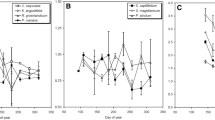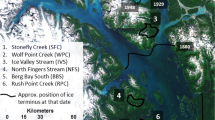Abstract
Nutrient availability in the arctic is expected to increase in the next century due to accelerated decomposition associated with warming and, to a lesser extent, increased nitrogen deposition. To explore how changes in nutrient availability affect ecosystem carbon (C) cycling, we used radiocarbon to quantify changes in belowground C dynamics associated with long-term fertilization of graminoid-dominated tussock tundra at Toolik Lake, Alaska. Since 1981, yearly fertilization with nitrogen (N) and phosphorus (P) has resulted in a shift to shrub-dominated vegetation. These combined changes have altered the quantity and quality of litter inputs, the vertical distribution and dynamics of fine roots, and the decomposition rate of soil organic C. The loss of C from the deep organic and mineral soil has more than offset the C accumulation in the litter and upper organic soil horizons. In the litter and upper organic horizons, radiocarbon measurements show that increased inputs resulted in overall C accumulation, despite being offset by increased decomposition in some soil pools. To reconcile radiocarbon observations in the deeper organic and mineral soil layers, where most of the ecosystem C loss occurred, both a decrease in input of new root material and a dramatic increase of decomposition rates in centuries-old soil C pools were required. Therefore, with future increases in nutrient availability, we may expect substantial losses of C which took centuries to accumulate.




Similar content being viewed by others
References
ACIA. 2004. Impacts of a Warming Arctic–Arctic Climate Impact Assessment. London: Cambridge University Press
Berg B. 1986. The influence of experimental acidification on nutrient release and decomposition rates of needle and root litter in the forest floor. For Ecol Manage 15:195–213
Berg B, Matzner E. 1997. Effect of N deposition on decomposition of plant litter and soil organic matter in forest systems. Environ Rev 5:1–25
Carreiro MM, Sinsabaugh RL, Repert DA, Parkhurst DF. 2000. Microbial enzyme shifts explain litter decay responses to simulated nitrogen deposition. Ecology 81:2359–2365
Chapin FS, Shaver GR. 1996. Physiological and growth responses of arctic plants to a field experiment simulating climatic change. Ecology 77:822–840
Chapin FS, Shaver GR, Giblin AE, Nadelhoffer KJ, Laundre JA. 1995. Responses of Arctic Tundra to experimental and observed changes in climate. Ecology 76:694–711
Chapin FS, Sturm M, Serreze MC, McFadden JP, Key JR, Lloyd AH, McGuire AD, Rupp TS, Lynch AH, Schimel JP, Beringer J, Chapman WL, Epstein HE, Euskirchen ES, Hinzman LD, Jia G, Ping CL, Tape KD, Thompson CDC, Walker DA, Welker JM. 2005. Role of land-surface changes in Arctic summer warming. Science 310:657–660
Dormann CF, Woodin SJ. 2002. Climate change in the Arctic: using plant functional types in a meta-analysis of field experiments. Funct Ecol 16:4–17
Fahey TJ, Hughes JW. 1994. Fine-root dynamics in a northern hardwood forest ecosystem, hubbard brook experimental forest, Nh. J Ecol 82:533–548
Fierer N, Allen AS, Schimel JP, Holden PA. 2003. Controls on microbial CO2 production: a comparison of surface and subsurface soil horizons. Glob Chang Biol 9:1322–1332
Fog K. 1988. The effect of added nitrogen on the rate of decomposition of organic-matter. Biol Rev Camb Philos Soc 63:433–462
Frey SD, Knorr M, Parrent JL, Simpson RT. 2004. Chronic nitrogen enrichment affects the structure and function of the soil microbial community in temperate hardwood and pine forests. For Ecol Manage 196:159–171
Gaudinski JB, Trumbore SE, Davidson EA, Zheng SH. 2000. Soil carbon cycling in a temperate forest: radiocarbon-based estimates of residence times, sequestration rates and partitioning of fluxes. Biogeochemistry 51:33–69
Gaudinski JB, Trumbore SE, Davidson EA, Cook AC, Markewitz D, Richter DD. 2001. The age of fine-root carbon in three forests of the eastern United States measured by radiocarbon. Oecologia 129:420–429
Haynes R. 1986. The decomposition process: mineralization, immobilization, humus formation, and degradation. In: Haynes R. (Ed.), Mineral Nitrogen in the Plant–Soil System. Orlando (FL): Academic
Hobbie SE. 1996. Temperature and plant species control over litter decomposition in Alaskan tundra. Ecol Monogr 66:503–522
Hobbie SE, Chapin FS. 1998. Response of tundra plant biomass, aboveground production, nitrogen, and CO2 flux to experimental warming. Ecology 79:1526–1544
Hobbie SE, Miley TA, Weiss MS. 2002. Carbon and nitrogen cycling in soils from acidic and nonacidic tundra with different glacial histories in Northern Alaska. Ecosystems 5:761–774
Hobbie SE, Gough L, Shaver GR. 2005. Species compositional differences on different-aged glacial landscapes drive contrasting responses of tundra to nutrient addition. J Ecol 93:770–782
Horwath JL. 2007. Quantification and Spatial Assessment of High Arctic Soil Organic Carbon Storage in Northwest Greenland. Department of Earth and Space Sciences. Seattle: University of Washington. p. 296
IPCC .2001. Climate change 2001: the scientific basis. In: Houghton JT, Ding Y, Griggs DJ, Noguer M, van der Linden PJ, Dai X, Maskell K, Johnson CA (Eds.), Contribution of Working Group I to the Third Assessment Report of the Intergovernmental Panel on Climate Change. Cambridge (UK): Cambridge University Press, 881pp
Jackson RB, Schenk HJ, Jobbagy EG, Canadell J, Colello GD, Dickinson RE, Field CB, Friedlingstein P, Heimann M, Hibbard K, Kicklighter DW, Kleidon A, Neilson RP, Parton WJ, Sala OE, Sykes MT. 2000. Belowground consequences of vegetation change and their treatment in models. Ecol Appl 10:470–483
Knorr M, Frey SD, Curtis PS. 2005. Nitrogen additions and litter decomposition: a meta-analysis. Ecology 86:3252–3257
Levin I, Kromer B. 2004. The tropospheric (CO2)–C-14 level in mid-latitudes of the Northern Hemisphere (1959–2003). Radiocarbon 46:1261–1272
Mack MC, Schuur EAG, Bret-Harte MS, Shaver GR, Chapin FS. 2004. Ecosystem carbon storage in arctic tundra reduced by long-term nutrient fertilization. Nature 431:440–443
Majdi H, Pregitzer K, Moren AS, Nylund JE, Agren GI. 2005. Measuring fine root turnover in forest ecosystems. Plant Soil 276:1–8
McKane RB, Rastetter EB, Shaver GR, Nadelhoffer KJ, Giblin AE, Laundre JA, Chapin FS. 1997. Climatic effects on tundra carbon storage inferred from experimental data and a model. Ecology 78:1170–1187
Nadelhoffer KJ, Johnson L, Laundre J, Giblin AE, Shaver GR. 2002. Fine root production and nutrient content in wet and moist arctic tundras as influenced by chronic fertilization. Plant Soil 242:107–113
Nommik H, Vantras K. 1982. Retention and fixation of ammonium and ammonia in soils. In: Stevenson F. (Ed.), Nitrogen in Agricultural Soils. Madison (WI): ASA, CSSA, and SSSA, pp. 123–171
Overpeck J, Hughen K, Hardy D, Bradley R, Case R, Douglas M, Finney B, Gajewski K, Jacoby G, Jennings A, Lamoureux S, Lasca A, MacDonald G, Moore J, Retelle M, Smith S, Wolfe A, Zielinski G. 1997. Arctic environmental change of the last four centuries. Science 278:1251–1256
Painter TJ. 1991. Lindow man, Tollund man and other peat-bog bodies––the preservative and antimicrobial action of Sphagnam, a reactive glycuronoglycan with tanning and sequestering properties. Carbohydr Polym 15:123–142
Perruchoud D, Joos F, Fischlin A, Hajdas I, Bonani G. 1999. Evaluating timescales of carbon turnover in temperate forest soils with radiocarbon data. Global Biogeochem Cycles 13:555–573
Serreze MC, Walsh JE, Chapin FS, Osterkamp T, Dyurgerov M, Romanovsky V, Oechel WC, Morison J, Zhang T, Barry RG. 2000. Observational evidence of recent change in the northern high-latitude environment. Clim Change 46:159–207
Shaver GR, Chapin FS. 1991. Production–biomass relationships and element cycling in contrasting Arctic vegetation types. Ecol Monogr 61:1–31
Shaver GR, Bret-Harte SM, Jones MH, Johnstone J, Gough L, Laundre J, Chapin FS. 2001. Species composition interacts with fertilizer to control long-term change in tundra productivity. Ecology 82:3163–3181
Sinsabaugh RL, Carreiro MM, Repert DA. 2002. Allocation of extracellular enzymatic activity in relation to litter composition, N deposition, and mass loss. Biogeochemistry 60:1–24
Southon J, Santos G, Druffel-Rodriguez K, Druffel E, Trumbore S, Xu XM, Griffin S, Ali S, Mazon M. 2004. The Keck carbon cycle AMS laboratory, University of California, Irvine: Initial operation and a background surprise. Radiocarbon 46:41–49
Stuiver M, Polach HA. 1977. Reporting of C-14 data––Discussion. Radiocarbon 19:355–363
Sturm M, McFadden JP, Liston GE, Chapin FS, Racine CH, Holmgren J. 2001. Snow-shrub interactions in Arctic tundra: a hypothesis with climatic implications. J Clim 14:336–344
Sturm M, Schimel J, Michaelson G, Welker JM, Oberbauer SF, Liston GE, Fahnestock J, Romanovsky VE. 2005. Winter biological processes could help convert arctic tundra to shrubland. Bioscience 55:17–26
Sullivan P, Sommerkorn M, Rueth HM, Nadelhoffer KJ, Shaver GR, Welker JA. 2007. Climate and species affect fine root production with long-term fertilization in acidic tussock tundra near Toolik Lake, Alaska. Oecologia (in press)
Tierney GL, Fahey TJ. 2002. Fine root turnover in a northern hardwood forest: a direct comparison of the radiocarbon and minirhizotron methods. Can J For Res Revue Canadienne De Recherche Forestiere 32:1692–1697
van Wijk MT, Clemmensen KE, Shaver GR, Williams M, Callaghan TV, Chapin FS, Cornelissen JHC, Gough L, Hobbie SE, Jonasson S, Lee JA, Michelsen A, Press MC, Richardson SJ, Rueth H. 2004. Long-term ecosystem level experiments at Toolik Lake, Alaska, and at Abisko, Northern Sweden: generalizations and differences in ecosystem and plant type responses to global change. Glob Chang Biol 10:105–123
Vogt K, Persson H. 1991. Measuring growth and development of roots. In: Lassoie J, Hinckley T. (Eds.), Techniques and Approaches in Forest Tree Ecophysiology. Boca Raton (FL): CRC
Weintraub MN, Schimel JP. 2003. Interactions between carbon and nitrogen mineralization and soil organic matter chemistry in arctic tundra soils. Ecosystems 6:129–143
Weintraub MN, Schimel JP. 2005. Nitrogen cycling and the spread of shrubs control changes in the carbon balance of arctic tundra ecosystems. Bioscience 55:408–415
Woodin SJ. 1997. Effects of acid deposition on arctic vegetation. In: Woodin SJ, Marquiss M (Eds.), Ecology of Arctic Environments. Oxford (UK): Blackwell Science, pp. 219–240
Xu XM, Trumbore SE, Zheng SH, Southon JR, McDuffee KE, Luttgen M, Liu JC. 2007. Modifying a sealed tube zinc reduction method for preparation of AMS graphite targets: reducing background and attaining high precision. Nucl Instrum Methods Phys Res B Beam Interact Mater Atoms 259:320–329
Acknowledgments
This research was supported by NSF grant DEB-0423385 and the Arctic LTER program. We thank G. Crummer and X. Xu for laboratory assistance and G. Goteti for assistance with the model, as well as E. Rastetter and two anonymous reviewers for their comments.
Author information
Authors and Affiliations
Corresponding author
Rights and permissions
About this article
Cite this article
Nowinski, N.S., Trumbore, S.E., Schuur, E.A.G. et al. Nutrient Addition Prompts Rapid Destabilization of Organic Matter in an Arctic Tundra Ecosystem. Ecosystems 11, 16–25 (2008). https://doi.org/10.1007/s10021-007-9104-1
Received:
Revised:
Accepted:
Published:
Issue Date:
DOI: https://doi.org/10.1007/s10021-007-9104-1




